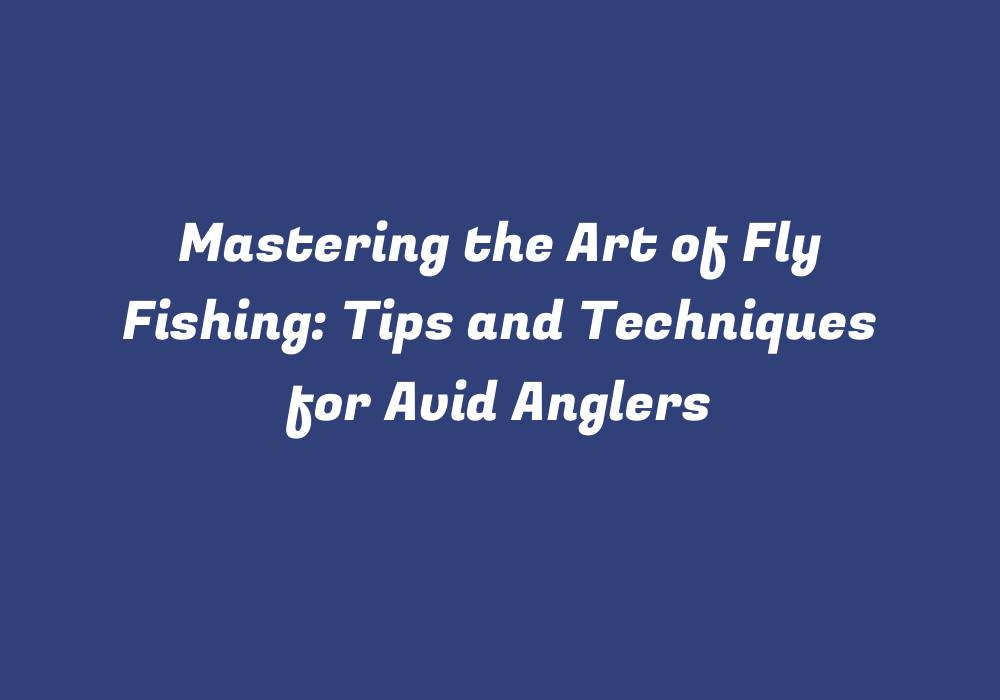Introduction to Mastering the Art of Fly Fishing
Fly fishing is an art that requires patience, skill, and a deep understanding of both fish behavior and the environment. Avid anglers who aspire to master this sport need to develop various techniques and strategies in order to catch more fish. From selecting the right equipment to knowing how to present your fly effectively, there are numerous tips you can use to enhance your fly fishing experience. This article aims to provide helpful advice for those eager to excel in their pursuit of the elusive trout or other types of game fish.
Choosing the Right Gear
Rod Selection: The first step toward mastering fly fishing is choosing a quality rod that suits your skill level, fishing location and the type of fish you wish to target. Generally, rods are categorized by action (flexibility) and weight (thrust). For beginners, an all-rounder rod with medium action will cover various water conditions and species well.
Reel and Line: Pair your chosen rod with a suitable reel. Reels come in various sizes and styles to cater for different fishing techniques. Consider the drag system, bearing quality, and overall build when selecting your reel. For fly lines, it’s best to match the weight of your line with the action of your rod. A 5-6wt fly line is recommended for beginners seeking a versatile setup.
Mastering Fly Fishing Techniques
Casting Techniques: Casting forms an essential part of the art of fly fishing. You need to develop accurate casts in both distance and direction, as well as be able to adapt your technique to different situations and locations. Start by practicing with a short line to develop proper casting mechanics.
Fly Presentation: Learn to present your flies naturally and accurately. This includes considering the depth of the water, the current, wind, and fish’s feeding behavior. Understanding how fish interact with their environment will help you select the right fly and present it effectively.
Fly Tying: While many anglers prefer to buy pre-tied flies, mastering the art of fly tying can greatly improve your fishing experience. By creating customized flies that suit local conditions, you’ll have more control over your results. Additionally, it allows you to tailor flies according to fish species, weather, and water conditions.
Developing a Strategic Approach
Location Selection: Choosing the right fishing spot is crucial in any fly fishing endeavor. Scout out your target locations by considering factors such as water depth, current speed, and habitat structure. Familiarize yourself with local regulations and understand the ecological impact of your actions to ensure responsible and ethical angling.
Reading Water: Observation is a key element of successful fly fishing. By understanding how fish interact with their environment, you’ll be better equipped to identify potential feeding spots or hiding places. Learn the behavioral patterns of your target species by observing their feeding habits, preferred habitats, and preferred water conditions.
Fishing Etiquette: Fly fishing is a sport that emphasizes conservation and the preservation of our natural resources. Always abide by local regulations, treat fish with care, and avoid causing unnecessary harm to their environment. Respect other anglers on the water and be mindful of your impact on the ecosystem.
Continuous Learning and Growth
Keep Practicing: Fly fishing is a sport that requires constant learning and refinement. Stay curious, experiment with new techniques, and continually improve your skills. Engage in fly fishing communities and workshops to stay updated on the latest developments within the industry.
Embrace the Challenge: Mastering the art of fly fishing is a lifelong journey filled with challenges, successes, and setbacks. Embrace this process as an opportunity for growth, personal development, and deeper appreciation for the outdoors. Remember, true enjoyment comes from the experience rather than just the catch itself.
Conclusion
Mastering the art of fly fishing requires a combination of dedication, patience, and continuous learning. From selecting the right gear to honing your casting techniques and developing strategic approaches, there are numerous elements that contribute to becoming an expert angler. With time and practice, you’ll discover the joy and satisfaction that come from mastering this challenging yet rewarding sport.
As you continue on your fly fishing journey, remember to share your knowledge with others in order to preserve the beauty of our natural world for future generations. By doing so, we can ensure the sustainability of this incredible pastime and maintain a deep connection to nature that is at the heart of the sport.
